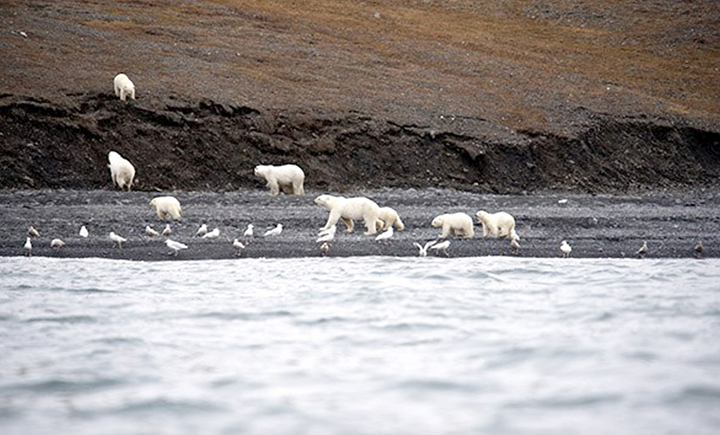by Steve Selden | Oct 2, 2017 | Churchill News

A “flock” of polar bears move towards a bowhead whale stranded on the coast of Wrangell Island. A Gruzdev photo.
When a bowhead whale beaches on a remote stretch of Wrangell Island the news spreads quickly. How it spreads is a mystery since polar bears were the recipients of the good fortune, not humans. According to nature reserve rangers on the island over 230 polar bears “flocked” to the scene of the stranding for a protein-packed meal.
At first glance travelers on a passing a Finnish cruise ship, the Akademik Shokalskiy, thought the bear congregation was a flock of sheep though they soon realized the Arctic is not Ireland so the white furry creatures had to be opportunistic polar bears. Males, females and even mothers with cubs ventured to the kill and got a piece of the whale pie.

Polar bears descend on a whale kill on Wrangell Island. A Gruzdev photo.
The cruise ship group had just made a layover and explored Wrangell, an island infamous for the last habitat of the extinct woolly mammoth.
Wrangell Island nature reserve staff have conveyed the details on the unique bear gathering to an international scientific group that monitors Alaska’s and Chukotka’s polar bear populations.
Wrangell Island lies in the Arctic Ocean between the Chukchi Sea and the East Siberian Sea.

Polar bears gather around a whale carcass on the coast of the Wrangell Island shore. A Gruzdev photo.

A polar bear at the Wrangel Island Nature Reserve. Wrangell Island Nature Reserve photo.
by Steve Selden | Jun 24, 2016 | Videos
Early September, high up on the Arctic’s North Slope, there is a feast truly hard to imagine! Around 80 polar bears gather each year along the rocky, frozen shores of Barter Island, just off the village of Kaktovik, where hunter-harvested bowhead whale remains await the hungry bruins. Since polar bears are generally known as solitary predators, this unique occurrence has peaked the interest of biologists in the north.
A small Inupiat hunting community, Kaktovik seemingly rests on the edge of the world, No roads or train tracks reach this northern outpost and packed sea – ice for nine months of the year isolates the town from most of the world. However, September beckons throngs of scientists and wildlife photographers to the speck of a town to document the incredibly voracious and unusual behavior. With more polar bears turning up year after year, biologists and climate researchers are working to solve the mystery of why this continues to draw a massive congregation of polar bears. Unlocking the clues of this migration is becoming paramount. The South Beaufort Sea polar bear population more and more is choosing to forage on land rather than the traditional sea – ice environment.
Inhabitants of Kaktovik, much like those of Churchill, Manitoba, become intertwined in their lives with the animals once the feast is over. The bears then meander towards town to see what else they can find. Perhaps dessert.
Todd Atwood is the lead polar bear scientist for the U.S. Geological Survey. Through his studies and research in the Arctic, he has estimated that polar bear numbers have declined 40% in the South Beaufort Sea area since 2006. Atwood is on a mission to find out the reason for the drastic decline.





